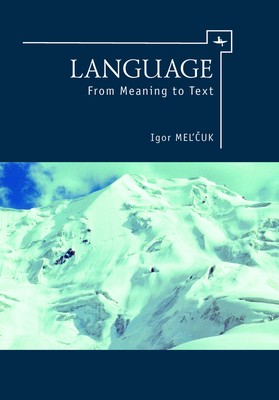
- We will send in 10–14 business days.
- Author: Igor Mel'čuk
- Publisher: Academic Studies Press
- ISBN-10: 1618114565
- ISBN-13: 9781618114563
- Format: 15.2 x 22.9 x 1.6 cm, hardcover
- Language: English
- SAVE -10% with code: EXTRA
Reviews
Description
This volume presents a sketch of the Meaning-Text linguistic approach, richly illustrated by examples borrowed mainly, but not exclusively, from English. Chapter 1 expounds the basic idea that underlies this approach--that a natural language must be described as a correspondence between linguistic meanings and linguistic texts--and explains the organization of the book. Chapter 2 introduces the notion of linguistic functional model, the three postulates of the Meaning-Text approach (a language is a particular meaning-text correspondence, a language must be described by a functional model and linguistic utterances must be treated at the level of the sentence and that of the word) and the perspective "from meaning to text" for linguistic descriptions. Chapter 3 contains a characterization of a particular Meaning-Text model: formal linguistic representations on the semantic, the syntactic and the morphological levels and the modules of a linguistic model that link these representations. Chapter 4 covers two central problems of the Meaning-Text approach: semantic decomposition and restricted lexical cooccurrence (≈ lexical functions); particular attention is paid to the correlation between semantic components in the definition of a lexical unit and the values of its lexical functions. Chapter 5 discusses five select issues: 1) the orientation of a linguistic description must be from meaning to text (using as data Spanish semivowels and Russian binominative constructions); 2) a system of notions and terms for linguistics (linguistic sign and the operation of linguistic union; notion of word; case, voice, and ergative construction); 3) formal description of meaning (strict semantic decomposition, standardization of semantemes, the adequacy of decomposition, the maximal block principle); 4) the Explanatory Combinatorial Dictionary (with a sample of complete lexical entries for Russian vocables); 5) dependencies in language, in particular--syntactic dependencies (the criteria for establishing a set of surface-syntactic relations for a language are formulated). Three appendices follow: a phonetic table, an inventory of surface-syntactic relations for English and an overview of all possible combinations of the three types of dependency (semantic, syntactic, and morphological). The book is supplied with a detailed index of notions and terms, which includes a linguistic glossary.
EXTRA 10 % discount with code: EXTRA
The promotion ends in 19d.15:53:46
The discount code is valid when purchasing from 10 €. Discounts do not stack.
- Author: Igor Mel'čuk
- Publisher: Academic Studies Press
- ISBN-10: 1618114565
- ISBN-13: 9781618114563
- Format: 15.2 x 22.9 x 1.6 cm, hardcover
- Language: English English
This volume presents a sketch of the Meaning-Text linguistic approach, richly illustrated by examples borrowed mainly, but not exclusively, from English. Chapter 1 expounds the basic idea that underlies this approach--that a natural language must be described as a correspondence between linguistic meanings and linguistic texts--and explains the organization of the book. Chapter 2 introduces the notion of linguistic functional model, the three postulates of the Meaning-Text approach (a language is a particular meaning-text correspondence, a language must be described by a functional model and linguistic utterances must be treated at the level of the sentence and that of the word) and the perspective "from meaning to text" for linguistic descriptions. Chapter 3 contains a characterization of a particular Meaning-Text model: formal linguistic representations on the semantic, the syntactic and the morphological levels and the modules of a linguistic model that link these representations. Chapter 4 covers two central problems of the Meaning-Text approach: semantic decomposition and restricted lexical cooccurrence (≈ lexical functions); particular attention is paid to the correlation between semantic components in the definition of a lexical unit and the values of its lexical functions. Chapter 5 discusses five select issues: 1) the orientation of a linguistic description must be from meaning to text (using as data Spanish semivowels and Russian binominative constructions); 2) a system of notions and terms for linguistics (linguistic sign and the operation of linguistic union; notion of word; case, voice, and ergative construction); 3) formal description of meaning (strict semantic decomposition, standardization of semantemes, the adequacy of decomposition, the maximal block principle); 4) the Explanatory Combinatorial Dictionary (with a sample of complete lexical entries for Russian vocables); 5) dependencies in language, in particular--syntactic dependencies (the criteria for establishing a set of surface-syntactic relations for a language are formulated). Three appendices follow: a phonetic table, an inventory of surface-syntactic relations for English and an overview of all possible combinations of the three types of dependency (semantic, syntactic, and morphological). The book is supplied with a detailed index of notions and terms, which includes a linguistic glossary.


Reviews